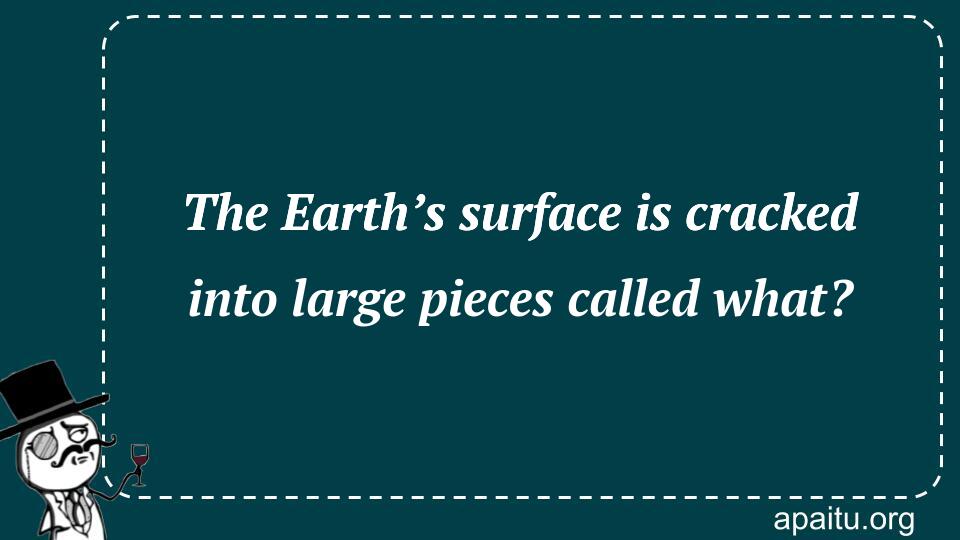Question
Here is the question : THE EARTH’S SURFACE IS CRACKED INTO LARGE PIECES CALLED WHAT?
Option
Here is the option for the question :
- Continents
- Pediments
- Tectonic plates
- Mantles
The Answer:
And, the answer for the the question is :
Explanation:
Large fragments of the Earth’s crust, known as tectonic plates, are present. These plates progressively move to create mountains, rifts, earthquakes, and volcanic activity through a process brought on by convection, which is triggered by the extremely hot rock present in the Earth’s core.

The Earth’s surface is far from being a static and unchanging entity. It is a dynamic and ever-evolving system that is cracked into large pieces known as tectonic plates. These plates, like gigantic puzzle pieces, fit together to form the Earth’s outer shell, also known as the lithosphere. The concept of tectonic plates revolutionized our understanding of the Earth’s geology and continues to shape our knowledge of earthquakes, volcanoes, and the formation of mountains.
Tectonic plates are massive sections of the Earth’s lithosphere that float on the semi-fluid layer beneath them, called the asthenosphere. These plates are composed of both continental and oceanic crust, which differ in composition and density. The Earth’s surface is divided into several major plates, including the Eurasian Plate, African Plate, North American Plate, South American Plate, Pacific Plate, and many others.
The movement of tectonic plates is driven by the convective currents in the underlying asthenosphere. Heat from the Earth’s interior causes the rock in the asthenosphere to slowly flow, creating the necessary forces to set the plates in motion. This movement can be described as either divergent, convergent, or transform.
Divergent boundaries occur where tectonic plates move away from each other. As the plates separate, molten rock from the underlying mantle rises to fill the gap, creating new crust. These boundaries often give rise to underwater mountain ranges and volcanic activity. The Mid-Atlantic Ridge, located in the middle of the Atlantic Ocean, is a prime example of a divergent boundary.
Convergent boundaries, on the other hand, are formed when two tectonic plates collide. Depending on the type of plates involved, different geological features can emerge. When an oceanic plate collides with a continental plate, the denser oceanic plate is forced beneath the lighter continental plate in a process known as subduction. This subduction can result in the formation of volcanic arcs, such as the Andes Mountains in South America. When two continental plates collide, their immense forces can uplift the Earth’s crust, leading to the formation of towering mountain ranges like the Himalayas.
Transform boundaries occur when two plates slide past each other horizontally. These boundaries are characterized by intense friction and can result in earthquakes, as the built-up stress is released when the plates suddenly slip. The San Andreas Fault in California is one of the most well-known transform boundaries.
The movement of tectonic plates has profound implications for our planet. Earthquakes, volcanic eruptions, and the formation of mountains are all consequences of plate tectonics. These processes shape our landscapes, create geological hazards, and contribute to the distribution of natural resources. The study of plate tectonics not only helps us understand these phenomena but also provides insights into the Earth’s history and the forces that have shaped our planet over billions of years.
tectonic plates are the large pieces into which the Earth’s surface is cracked. These plates, composed of continental and oceanic crust, float on the semi-fluid asthenosphere and are in constant motion. Divergent boundaries separate plates, convergent boundaries bring them together, and transform boundaries allow them to slide past each other. The movement of tectonic plates gives rise to earthquakes, volcanic activity, and the formation of mountains, shaping the Earth’s surface and influencing the dynamic processes occurring beneath our feet. The study of plate tectonics is crucial for understanding the geology of our planet and helping us prepare for and mitigate the impacts of geological events.